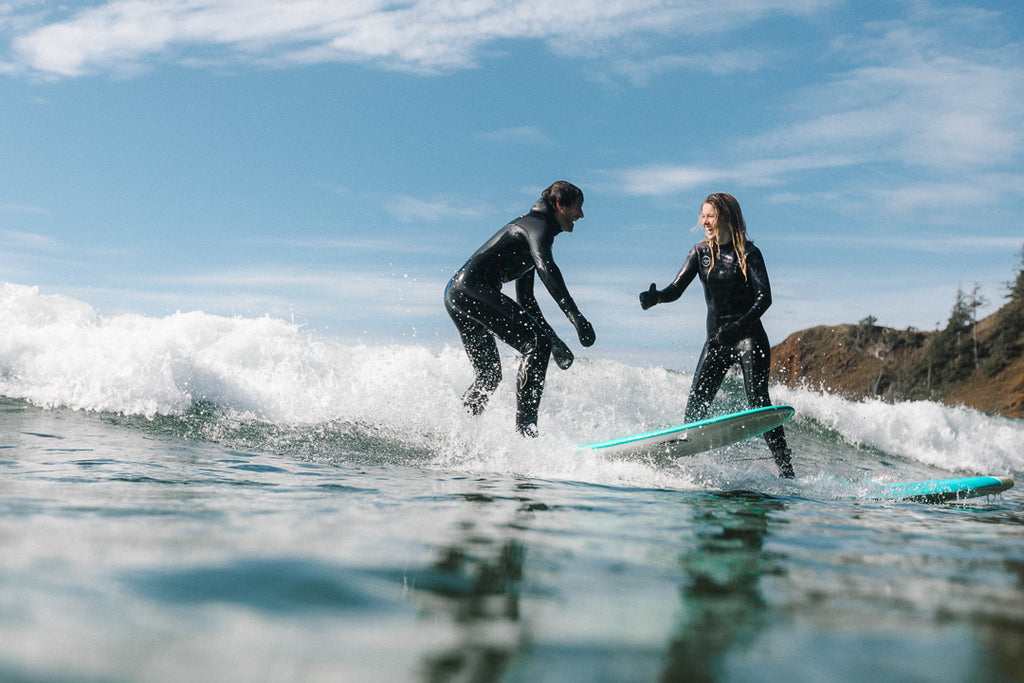Surf Forecasting 101

To get to the surf from my home base of Squamish, British Columbia requires a bit of effort. First, you’ll need to drive south on Highway 99 for about forty five minutes. Then hop on a ferry for a 1.5 hour ride over to Vancouver Island. From there, you’re either doing a 2 or 3 hour drive out to the coast depending on if you choose the north or south part of the island.
It’s a long trip, and with limited time it’s important to nail the forecast. No matter how much research you’ve done, you’re going to have some bad days. The west coast of Vancouver Island is a rugged, wild place—unexpected storms roll in off the Pacific and slam the coast bringing biblical amounts of rain, wind, and of course, swell.

Any day at the beach is a good one—but some are better than others.
In order to make the aforementioned journey worth it, it’s important to understand forecasting—something I learned early in my surf career. I’ve made a slew of mistakes—making the long drive only to realize I had never actually checked the wind forecast, or flying into to a remote beach for a 5-day trip only to realize that the beach we were surfing was facing the completely wrong direction for all the swell coming in.
Along the way, I learned a few lessons. Below, I’ll do my best to highlight some pain points that might be helpful to help you understand what’s going on.
Wind, Wind, Wind and Wind
Wind, even the slightest bit, can make or break a session. Understanding how the wind will work at a beach takes experience and attentiveness. For example, even if the arrow on Magic Seaweed is ‘green’ (typically indicating offshore wind), that doesn’t always mean the wind will be pumping offshore—it’s important to cross-reference another source, looking at wind direction and beach direction, and use that to dictate your decision.
Photo 2: Glassy moments like this can turn a session from good to unforgettable.
On top of that, take a look next time you’re at the beach—if the wind is offshore, record the direction it’s coming from, and then you’ll know what makes conditions perfect at your local break.
Swell Direction Matters
Last May we packed out bags and head to the northern tip of Vancouver Island for what was looking to be the trip of a lifetime. The swell was coming in at 6 feet at 14 seconds directly from the west, and we were stoked—the only problem? The beach we were flying into was heavily south facing, with a headland blocking the swell from the west.

Timing things perfectly can often work out, but sometimes you are still waiting for surf!
While the trip wasn’t a total bust (we spent 4 days on the beach and got a few waves, who could complain?), we had learned a vital lesson: always look at swell direction and beach direction.
Pay Attention to the Tides
Before I started surfing, the tide really only ever came up when my Mom talked about her beach walks—she always kept an eye on it so she didn’t have to get her feet wet.
But in surf, it plays a vital role. Some reefs and points can be unsurfable at low tide, and beach breaks can be far too mushy at high tide. Just as easily, the opposite can be true.

The slightest changes in tide can lead to big changes in how the surf lines up—pay attention, you won’t regret it.
A useful resource for this conundrum is surf forecasting sights like Magic Seaweed and Surfline, which indicate which spots work well at which tides. It’s important to note that these predictions are aren’t always perfect, which leads me to my next point…
Always Check!
Disregard everything I’ve said above, and get off your couch and go to the beach. Forecasts can be wrong, like when the meteorologist told you it was going to rain so you cancelled your plans, only to wake up to a bluebird day.

Load up the rig and go for a look, you never know what you’re gonna get!
Surf forecasts are undoubtedly complex, and the best way to understand what’s going on at the beach is to go to the beach. Worst case scenario, you’re at the beach. Best case? You’re surfing an empty lineup of perfect surf because of the rest of the world stayed at home.
In the end, what’s important is getting out there. As you spend more time in the ocean, you’ll become more in tune with what those complicated numbers and arrows means, and you’ll be scoring whenever the surf is up.
Written by Degree 33 Ambassador Ben Osborne






